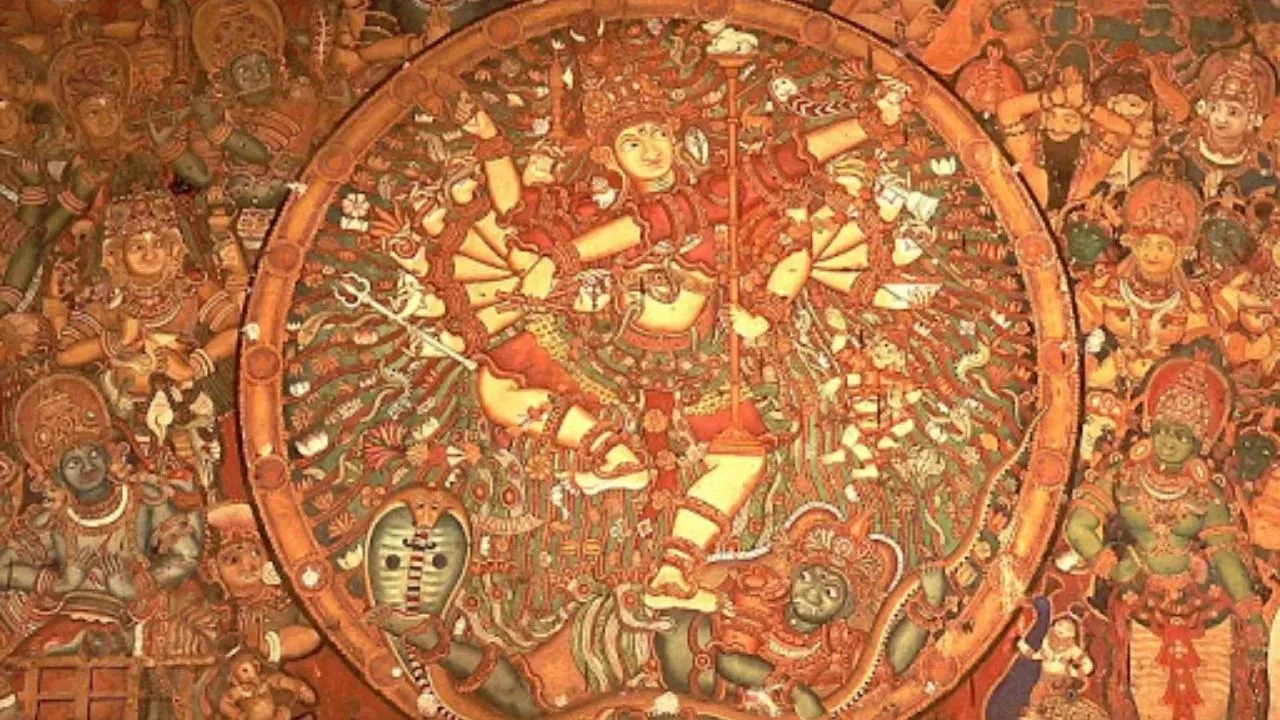Your Cart
Kerala Mural
Let's explore the Kerala Mural Paintings!
Introduction
Etymology: The word Mural is derived from the Latin term 'murus,' which means wall. These paintings are painted on huge surfaces similar to walls, such as ceilings, cave walls, etc., the name of these paintings is justified.
Origin: The origin of mural paintings in India can be traced back to the 2nd century BCE caves of Ajanta, Bagh, and Sithanavasal. But the earliest discovery of the Kerala mural dates back to the 8th century BCE in a shrine at Thirunandikkara, which is located in the present Kanyakumari district in the state of Tamil Nadu.
Location: The state of Kerala is situated on the Southwestern coast of peninsular India. This style of painting is seen in Kerala, which is also called 'God's own country'.
Community: The temple community practised this art form for centuries. The temple priests used the large walls of the shrine as the base for these paintings. Others created this art on the walls of their houses. Eventually, the Kerala murals were introduced to the walls of churches. This was due to the increasing arrivals of Christian missionaries in the state and sections of the local community adopting the new religion. This led to a mixing of cultural arts. A very prominent painter of Kerala, Raja Ravi Verma, converged the Indian and Western styles in this painting tradition.
Relevance: It resembles the early mural paintings in the form of rock art seen in the Anjanad valley in the region of Idukki as well as the rock engravings seen in the Edkkal and Wayanad caves.
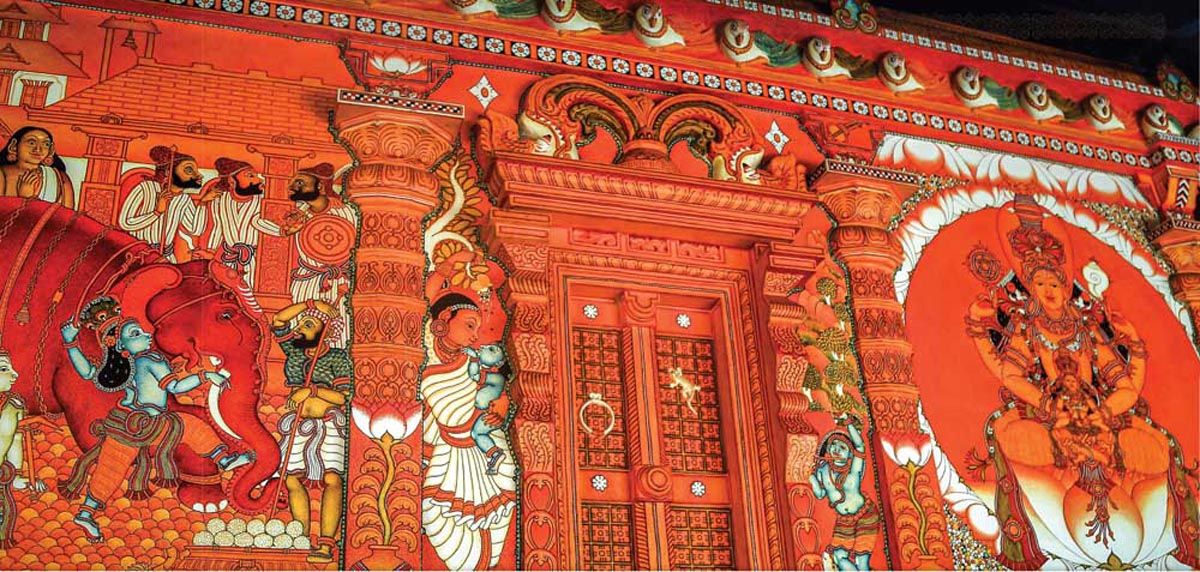
History
Historical Background: In Kerala, wall engraving and painting date back to the 7th and 8th centuries. It has the second-largest number of archaeologically significant mural sites in India. These paintings are thought to date from various historical periods, including the upper Paleolithic and the early historic civilizations. Kerala mural painting is distinctly unique from other mural painting styles because of its vibrancy and elegance. In Kerala, over 150 temples have historical mural paintings, and a large number of these murals date to the 14th century.
Culture and Societies: The social structure used to be so conservative that a person's status was judged by their inhabitation. Religious people with higher social status had enough wall space to paint murals. The desires of people on the lower levels of society gave rise to the folk art form of 'Kalamezhuthu' which is intangible, enduring, and performative in nature. Later, this society converged this folk art with their religious rites.
Religious Significance: In the temples, the paintings are worshipped alongside the murti (idol of god). Puranas and epics are also depicted across many sites, including palaces. One such palace is the 'Mattancheri Palace' in Cochin, where Ramayana illustrations can be found. Earlier versions of this painting style are seen in the temple shrines at Tirunandikara, Kanthalloor, Padmanabhaswamy, and Tiruvampady. In Kerala churches, a space was eventually created for visual art, which was used for both decoration and the visual expression of moral principles.
Legends or Myths: Castaneda, a Portuguese explorer who followed Vasco da Gama on his voyage to India in 1498, landed in Kappad, a town close to Kozhikode. Along with his friends, he entered a Hindu temple while documenting this experience, mistaking it for a local church. They had major doubts about whether or not they were in a Christian church when they saw 'monstrous-looking images' painted on the walls. It is believed that these navigators may have visited a Bhagavati temple located between Kappad and Kozhikode.
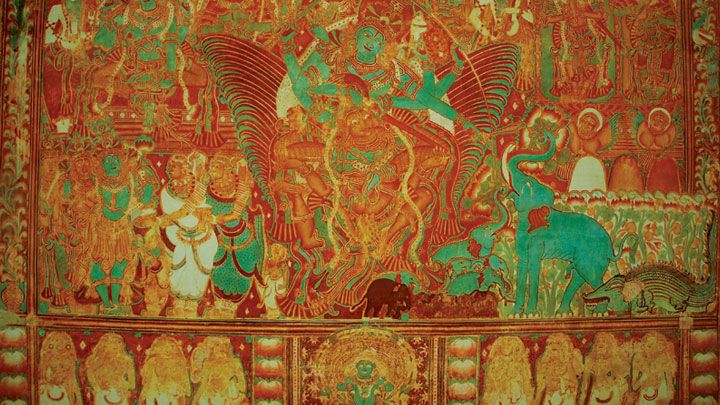
Understanding the art
Central Motifs and their Significance: Since traditional murals are found in temples, they are votive to the temple's main deity as they majorly depict some mythologies associated with the installed deity. Also, depictions of Hindu gods and goddesses, local deities, and epics from the Puranas are included in expressing their navarasas (nine emotions/expressions). At the same time, the remaining spaces are filled with beautiful motifs of flora and fauna. Later, Christian themes were introduced in churches that were established after the Western nation invasions, especially in Kerala.
Mediums Used: Five colours - red, yellow, green, black, and white, known as panchavarana in Sanskrit, are typically utilised in Kerala murals. The colours are obtained naturally from mineral or plant pigments. The green is produced from the extract of neelamari (Indian indigo) leaves. As a binding agent, coconut water, neem tree oil, and various tree gum extracts are used. Traditionally, elephant grass (kuntalipullu) and ketaki roots, and rare animal hair were used as brushes. Palettes made from wood were used for mixing the colours.
Style: The unique linear structure in the Kerala mural paintings creates a perfect portrayal of their style. The expressions are designed skillfully. Especially the lips are painted in the noticeable stippling technique. They also have rich and glamorous ornamentation on their bodies and hands (mudras).
Process: The muralist is a skilled illustrator who specialises in creating painting surfaces that last for generations without fading. Earlier, kadukkai (Indian hog plum) juice, lime, sand, and palm sugar (jaggery) were used to prepare the walls. Then, a smooth plaster using a similar mixture that also adds ground cotton is applied. After 10 days, to reach a thickness of 0.5 inches, 25 to 30 coats of quicklime mixed with coconut water are applied. The following 6 steps are sequentially done while painting the murals -
- Lekhya karma - The outline of the subjects is sketched in a light yellow colour.
- Rekha karma - The outlines are drawn precisely to maintain the dimensions of the painting.
- Varna karma - The process of filling the colours is done.
- Vartana karma - After the colouring, shading is done to add richness and definition to the paintings.
- Lekha karma - The final outlines are finished.
- Devika karma - after completing all the detailed work, the eyes of the deities are drawn.
A final fine coat of resin is applied to preserve and add luster to the painting.
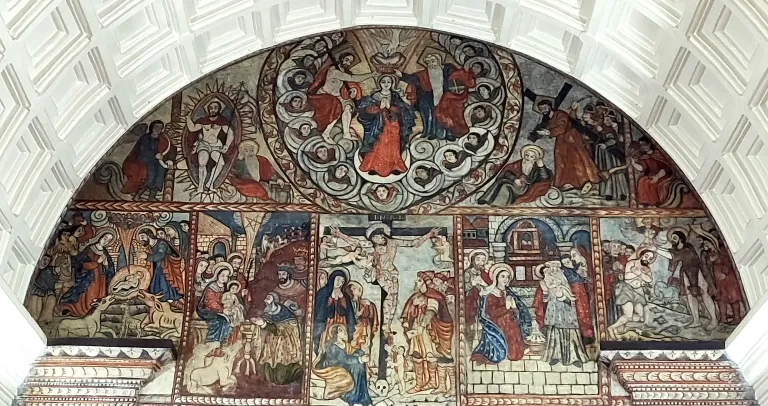
New Outlook
Kerala Mural has rapidly gained popularity in the fashion and design sectors due to its modernity and vibrant colour palette. Murals from Kerala are used in the design of many home decor. In the fashion industry, it may be seen on many different kinds of clothes, such as sarees, dress fabrics, dupattas, and even shirts. Kerala Murals have been painted on the walls of some palaces, houses, and commercial spaces. One such illustration is the work by Suresh Muthukulam and his students at the Mumbai International Airport, which still maintains the old mural style's features and is easily recognisable.
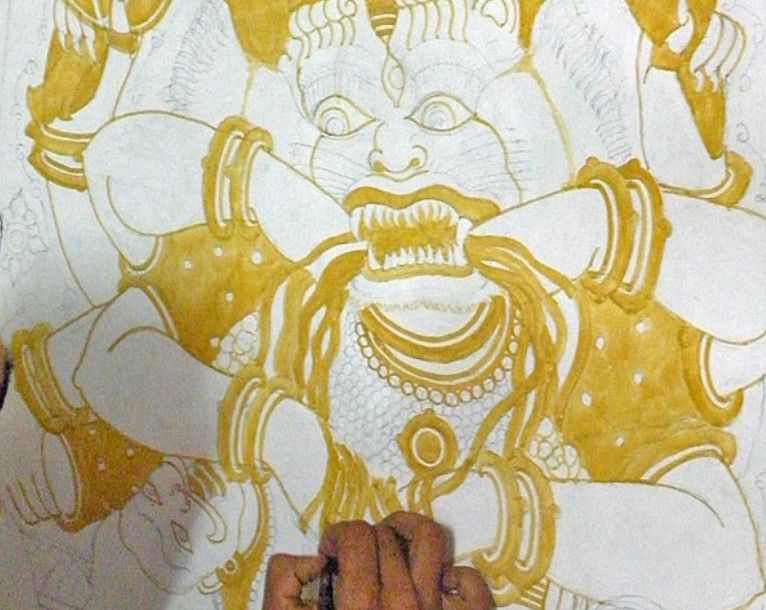
Books
Ramachandran, A. (2005) Painted Abode of Gods Mural Traditions of Kerala. New Delhi: Indira Gandhi National Center for the Arts.
Nambirajan, Dr.M., Suresh, Dr.S. (2015) Kerala Murals. New Delhi: Archaeological Survey Of India.
